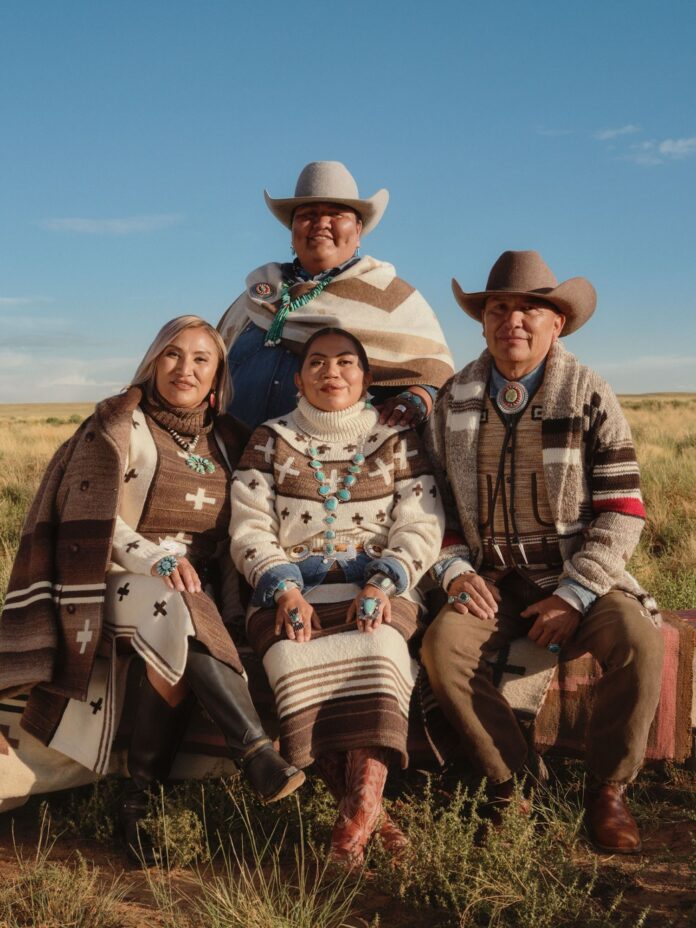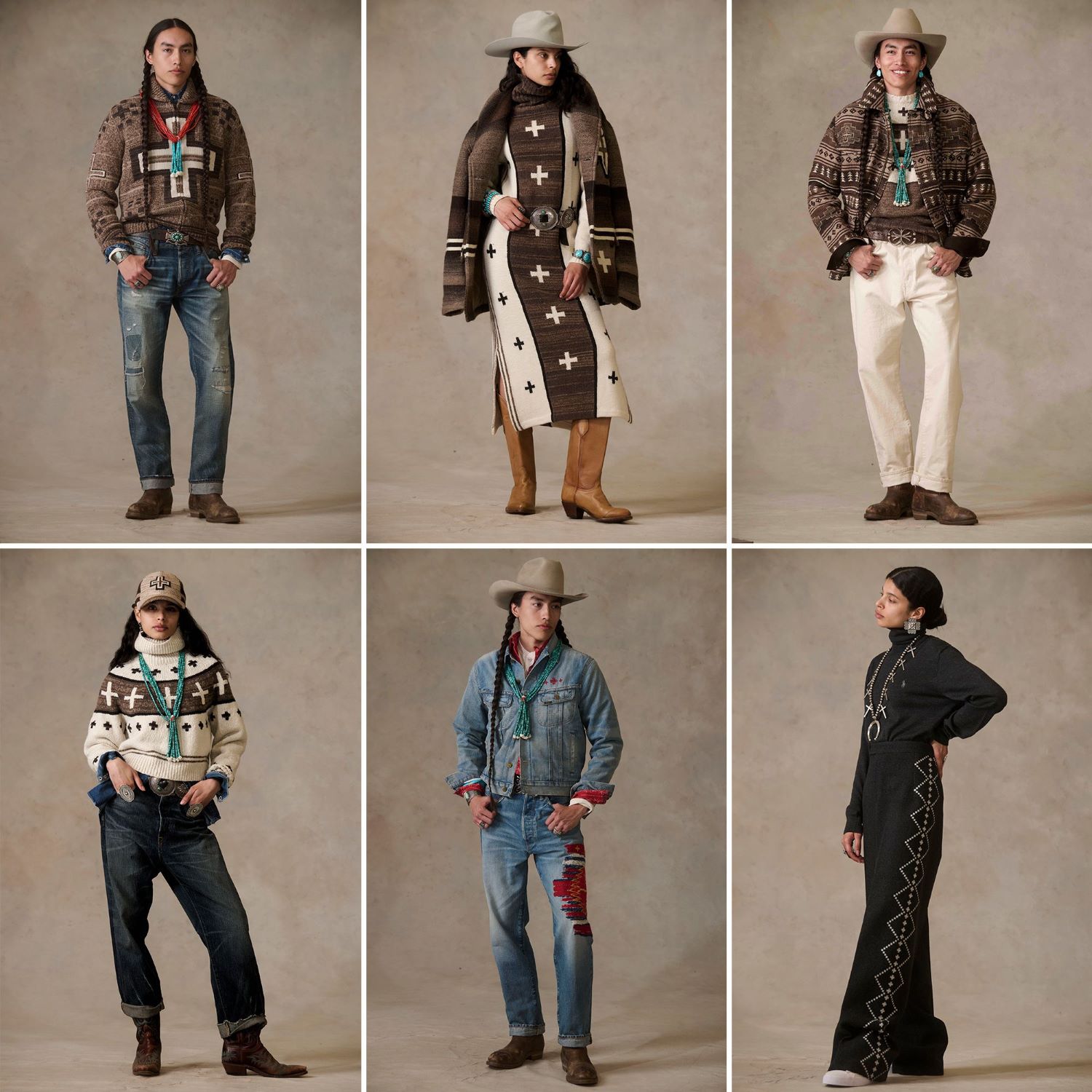
(CNN) — Growing up in Rock Point, Arizona in the Navajo Nation, Ralph Lauren’s inaugural “artist in residence,” Naiomi Glasses, already held a close connection with the New York City-based label.
“It’s always been a brand that I can associate with family,” the seventh-generation Diné (Navajo) textile artist and weaver told CNN, recalling how her mom would dress her in Ralph Lauren polos, Oxford shoes and knit dresses, but paired with traditional Diné pieces — a fashion practice she continues today. (Diné is translated as “the people” in the community’s own language; “Navajo” is derived from the Tewa-Pueblo term “nava hu,” or “place of large planted fields.”)
Family is extremely important to Glasses, who learned weaving from her paternal grandmother and her brother (and design partner). Glasses initially envisioned creating “floor rugs, blankets and possibly fashion” as a career path — though “possibly” turned out to be quite the understatement.
“I really have to thank both my mom Cynthia and my dad Tyler Sr. for instilling this confidence in me,” said Glasses, crediting her parents for encouraging her to realize her dreams — and of working with Ralph Lauren specifically.
After finishing an internship with Creative Futures Collective, which paired her with Gabriella Hearst to weave colorful details onto the designer’s Spring-Summer 2022 runway pieces, she received a call from the organization’s co-founder Jai Al-Attas: “I met someone that works at Ralph Lauren,” she recalled them saying. “And apparently, they have been wanting to get in contact with you.”
Redefining ‘heritage’
Since its foundation in 1967, Ralph Lauren has established itself as a fashion arbiter of a singular “Americana” aesthetic, oft-associated with its iconic polo shirts, cable-knit sweaters and khakis. Historically, the country club uniform, and its related culture, conjures connotations both of exclusivity and exclusion, but in recent years the label has worked to redefine its brand means to consumers.
In 2020, Ralph Lauren launched initiatives to expand its “collegiate sensibility,” which first resulted in a 2022 collaboration with Morehouse and Spelman Colleges incorporating the traditions and styles of historically Black colleges and universities. That same year, it announced the “artist in residence” series, which highlights Native and Indigenous artisans — a program that’s part of “broader efforts to shift from inspiration to collaboration with communities that have inspired Ralph Lauren,” the label said in a statement.
“Ralph Lauren has always been inspired by the people, art and cultures that make up America,” wrote David Lauren, son of founder Ralph and the company’s chief branding and innovation officer, in an email to CNN. “What has changed is how we are bringing these stories to life and ensuring that we do so in a way that is inclusive of those who own them.”
“We are a window for the world into America — not just American style,” he added. “That’s a real responsibility, and that means continuously asking ourselves what is inspirational and aspirational to us and pushing ourselves to be more and more authentic in the stories we tell.”
The Polo Ralph Lauren x Naiomi Glasses collaboration kicks off the program on December 5, with the first of three seasonal limited edition drops featuring menswear, womenswear, unisex apparel and accessories.
“For the longest time, Americana fashion hasn’t included designers of Indigenous descent, and we are the first people of this land,” said Glasses. “This collection will definitely broaden what ‘Americana’ fashion can be.”
The designer, activist and TikTok-famous skateboarder enthusiastically “reimagined” signature Ralph Lauren silhouettes, like the Great Ranch Coat, an outerwear piece she’d admired for years. “I already had envisioned what would look really beautiful on it,” said Glasses: She proposed a fabrication of undyed wool, blended with soft alpaca fleece, to evoke the feel and meaning of “wearing blankets,” which the Diné and Indigenous people cherish both for functionality and as heirlooms (though her versions are “more modernized,” she added).
Glasses also worked closely with the Ralph Lauren design teams to incorporate meaningful Diné motifs and “little nuances” into the collection, like directional weaving patterns and the Spider Woman cross symbol on shawl collar coats and poncho wraps. “The spider woman is a deity from our Navajo creation story, who taught Navajos how to weave,” she explained.
Other motifs, also including Saltillo diamonds and four-directional crosses, represent traditional Diné design elements — and, significantly, ones that pre-date those popularized after the arrival of late-1800s colonial trading posts, and other outside influences catering to White settlers, saw many of the community’s practices altered and appropriated.

Mandatory Credit: Courtesy Ralph Lauren
Making fashion history
In other words, Glasses’ celebration of her “Americana” is also about reclaiming it. “Navajo pieces (originally) were mostly utilitarian and just designs that we, as Diné, thought were beautiful,” Glasses said. “So it was just me, weaving exactly how they would, just true to their own style.”
A particularly meaningful part of Glasses’ long-time fascination with Ralph Lauren’s brand has been with its accessories; she recalled, as a teenager, being awestruck by the gleaming jewelry pieces on display at the label’s flagship in Phoenix. At the time, Glasses had already begun amassing an impressive turquoise collection, inspired by her grandmother.
Now as part of her residency’s work, Glasses is paying it forward by giving a platform to contemporary Indigenous jewelry makers, including Hopi designer Piki Wadsworth, whose silver and turquoise pieces, will be available online and in select Ralph Lauren flagships.
I thought it was very important that I brought up other Indigenous creatives along with me on this journey,” she said.
The curated jewelry, along with pieces from Glasses’ own archive and, of course, her clothing designs all grace a stunning new campaign, lensed by Osage multihyphenate and “Reservation Dogs” writer Ryan RedCorn and Navajo photographer (and Glasses’ friend) Daryn Sells.
Across the campaign’s photos and video, Glasses felt especially heartened to see Indigenous representation, in-front-of- and behind-the-camera. “Ryan was able to capture key important moments, even something as simple as joy and laughter,” she explained. “He’s like, ‘It’s important that we capture these things because for so long, we, as indigenous people, are painted as being stoic.’ There’s beauty in seeing Indigenous joy.”
That’s also because along with the likes of famous models Quannah Chasinghorse and Phillip Bread, and the musician Mato Mayuhi, the campaign’s lineup also included Glasses herself, her brother, Tyler, and their parents.
“In a production that big, just having that connection with a community of people that you knew being there, it felt special,” said Glasses. “There were a lot of people I hold near and dear.”


